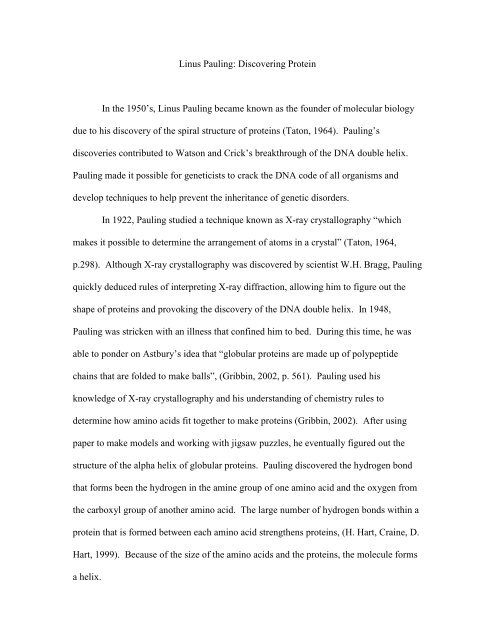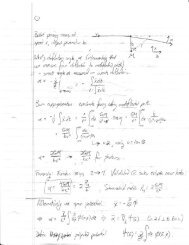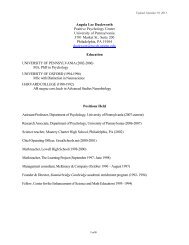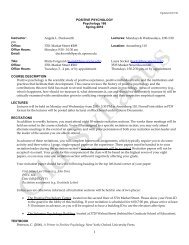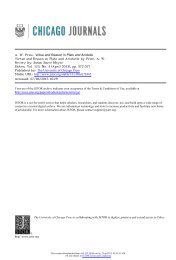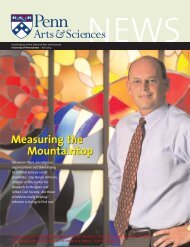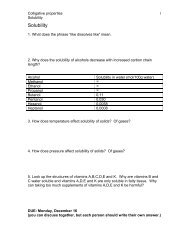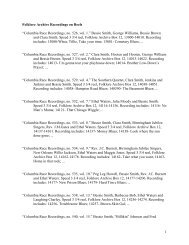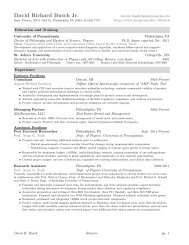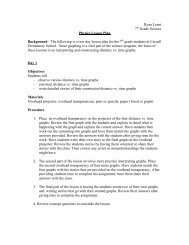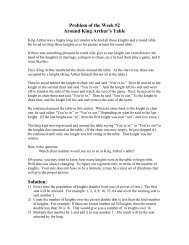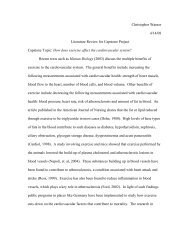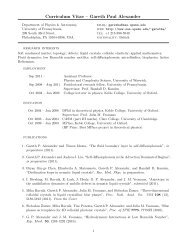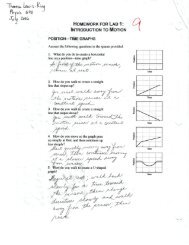Linus Pauling: Discovering Protein In the 1950's, Linus Pauling ...
Linus Pauling: Discovering Protein In the 1950's, Linus Pauling ...
Linus Pauling: Discovering Protein In the 1950's, Linus Pauling ...
You also want an ePaper? Increase the reach of your titles
YUMPU automatically turns print PDFs into web optimized ePapers that Google loves.
<strong>Linus</strong> <strong>Pauling</strong>: <strong>Discovering</strong> <strong>Protein</strong><br />
<strong>In</strong> <strong>the</strong> 1950’s, <strong>Linus</strong> <strong>Pauling</strong> became known as <strong>the</strong> founder of molecular biology<br />
due to his discovery of <strong>the</strong> spiral structure of proteins (Taton, 1964). <strong>Pauling</strong>’s<br />
discoveries contributed to Watson and Crick’s breakthrough of <strong>the</strong> DNA double helix.<br />
<strong>Pauling</strong> made it possible for geneticists to crack <strong>the</strong> DNA code of all organisms and<br />
develop techniques to help prevent <strong>the</strong> inheritance of genetic disorders.<br />
<strong>In</strong> 1922, <strong>Pauling</strong> studied a technique known as X-ray crystallography “which<br />
makes it possible to determine <strong>the</strong> arrangement of atoms in a crystal” (Taton, 1964,<br />
p.298). Although X-ray crystallography was discovered by scientist W.H. Bragg, <strong>Pauling</strong><br />
quickly deduced rules of interpreting X-ray diffraction, allowing him to figure out <strong>the</strong><br />
shape of proteins and provoking <strong>the</strong> discovery of <strong>the</strong> DNA double helix. <strong>In</strong> 1948,<br />
<strong>Pauling</strong> was stricken with an illness that confined him to bed. During this time, he was<br />
able to ponder on Astbury’s idea that “globular proteins are made up of polypeptide<br />
chains that are folded to make balls”, (Gribbin, 2002, p. 561). <strong>Pauling</strong> used his<br />
knowledge of X-ray crystallography and his understanding of chemistry rules to<br />
determine how amino acids fit toge<strong>the</strong>r to make proteins (Gribbin, 2002). After using<br />
paper to make models and working with jigsaw puzzles, he eventually figured out <strong>the</strong><br />
structure of <strong>the</strong> alpha helix of globular proteins. <strong>Pauling</strong> discovered <strong>the</strong> hydrogen bond<br />
that forms been <strong>the</strong> hydrogen in <strong>the</strong> amine group of one amino acid and <strong>the</strong> oxygen from<br />
<strong>the</strong> carboxyl group of ano<strong>the</strong>r amino acid. The large number of hydrogen bonds within a<br />
protein that is formed between each amino acid streng<strong>the</strong>ns proteins, (H. Hart, Craine, D.<br />
Hart, 1999). Because of <strong>the</strong> size of <strong>the</strong> amino acids and <strong>the</strong> proteins, <strong>the</strong> molecule forms<br />
a helix.
Images taken from google images<br />
Because <strong>Pauling</strong> determined <strong>the</strong> alpha helix of globular proteins, he was able to<br />
contribute to <strong>the</strong> discovery of <strong>the</strong> difference in <strong>the</strong> hemoglobin between people with and<br />
without sickle-cell. <strong>In</strong> 1940, a medical student at Johns Hopkins by <strong>the</strong> name of Irving<br />
Sherman noticed a difference in <strong>the</strong> transmission of light through red blood cells of<br />
patients with and without sickle cell, (Bloom, 1995). Dr. William Castle of Harvard told<br />
<strong>Pauling</strong> about Sherman’s observation one day on a train ride. <strong>Pauling</strong> later performed a<br />
technique comparing proteins among people with sickle cell, without sickle cell and<br />
carrying a gene for sickle cell (Bloom, 1995). He found that <strong>the</strong> hemoglobin of those<br />
with sickle cell differed from those without it. The carriers of sickle cell had both types<br />
of hemoglobin, (Bloom, 1995). <strong>Pauling</strong> concluded that <strong>the</strong>re is a difference in a gene of<br />
<strong>the</strong> two types of protein.
<strong>In</strong> 1956, Vernon <strong>In</strong>gram of Cambridge fur<strong>the</strong>r studied <strong>the</strong> protein hemoglobin<br />
(Bloom, 1995). Hemoglobin is a protein in red blood cells that allows oxygen to bind<br />
and be transported to various tissues within <strong>the</strong> body, (Platt & Sacerdote, 2002). The<br />
abnormal shape of red blood cells of people with sickle cell prevents oxygen from<br />
binding which causes <strong>the</strong>m to receive less than adequate amounts of oxygen. The lack of<br />
oxygen to organs causes pain and damaged red blood cells become destroyed leading to<br />
anemia, (Platt and Sacerdote, 2002).<br />
The following picture shows sickle shaped red blood cells and normal shaped red blood<br />
cells.<br />
Images taken from google images<br />
www.pueblo.gsa.gov<br />
Image taken from google images<br />
http.www.defiers.com
Cambridge discovered that <strong>the</strong> amino acid valine was present in <strong>the</strong> hemoglobin<br />
of people with sickle cell and glutamic acid was in <strong>the</strong> hemoglobin of people without<br />
sickle cell. Both valine and glutamic acid have a steric number of 3, trigonal planar<br />
geometry, sp2 hybridization, and a bond angle of 120. This difference between valine<br />
and glutamic acid that affects <strong>the</strong> bonding of oxygen is <strong>the</strong> side chain. Glutamic acid, <strong>the</strong><br />
amino acid in normal hemoglobin has an acidic side chain, but valine, <strong>the</strong> amino acid in<br />
abnormal hemoglobin, has a nonpolar side chain. The side chain in all amino acids<br />
always faces outward. (Hart et al, 1999). Valine’s nonpolar side chain, which faces<br />
outward is hydrophobic and will not form a hydrogen bond with oxygen. This<br />
deoxygenated hemoglobin begins to clump causing <strong>the</strong> red blood cells to form a sickled<br />
shape in those with or carrying a gene for sickle cell (McMurry & Fay, 1995).<br />
VALINE<br />
GLUTAMIC ACID<br />
Molecules in black are <strong>the</strong> side chains that vary in each of <strong>the</strong> 20 amino acids, giving<br />
<strong>the</strong>m <strong>the</strong>ir unique properties. Red are <strong>the</strong> common structure in amino acids.<br />
Images taken from http://inquiry.uiuc.edu/bioweb/tutorial/amino_acids.htm<br />
Contributions made by <strong>Pauling</strong>, Mendel, Watson and Crick, just to name a few,<br />
have laid <strong>the</strong> foundation for <strong>the</strong> technological advances such as <strong>the</strong> human genome<br />
project and stem cell research. However, just as controversy existed in <strong>the</strong> past<br />
concerning <strong>the</strong>se advances, <strong>the</strong>y continue to exist. According to Aldous Huxley’s Brave<br />
New World says “Work, play-at sixty our powers and tastes are what <strong>the</strong>y were at<br />
seventeen. Old men in <strong>the</strong> bad old days used to renounce, retire, take to religion, spend<br />
<strong>the</strong>ir time reading, thinking-thinking!” (Huxley,1932, p.55).
BIBLIOGRAPHY<br />
Bloom, M (1995). Understanding Sickle Cell Disease. Mississippi: University Press of<br />
Mississippi.<br />
Federal Citizen <strong>In</strong>formation Center. (February 1, 1999). New Hope for People with<br />
Sickle Cell Anemia. [Online service textfile]. Pueblo, Colorado. Mayfied, M.<br />
Retrieved April 26, 2006 from <strong>the</strong> World Wide Web:<br />
http://www.pueblo.gsa.gov/...sicklecell/496.sick.html<br />
Gribbin, J (2002). The Scientists: A History of Science Told Through <strong>the</strong> Lives of Its<br />
Greatest <strong>In</strong>ventors. New York: Random House.<br />
Hart., H. & Craine. L., & Hart., D. (1999). Organic Chemistry (10 th ed.)<br />
New York: Houghton Mifflin Company.<br />
Huxley, A. (1932). Brave New World. New York: Harper Collins Publishers.<br />
McMurry, J., & Fay, R., (1995). Chemistry. New Jersey: Prentice Hall.<br />
Morrison, B., & Boyd, R., (1992). Organic Chemistry. (6 th ed). New Jersey: Prentice<br />
Hall.<br />
National Academy of Sciences. Biographical Memoirs. <strong>Linus</strong> <strong>Pauling</strong>. [Online service<br />
textfile]. Dunitz, Jack. Retrieved March 15, 2006 from <strong>the</strong> World Wide Web:<br />
http://www.defiers.com/scd.html<br />
Platt, F,. & Sacerdote, A., (2002). Hope and Destiny. Illinois: Hilton Publishing<br />
Company.<br />
Statement of <strong>the</strong> Basic Aims and Objectives of <strong>the</strong> Sickle Cell Advocates for Research<br />
and Empowerment, <strong>In</strong>c. (1997). What is Sickle Cell Disease? (Online service<br />
textfile]. NIH. Author. Retrieved April 26, 2006 from <strong>the</strong> World Wide Web:<br />
http.www.pueblo.gsa.gov/..sicklecell/496.sick.html


